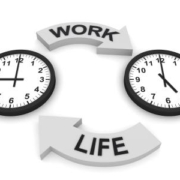Remote Working Hacks: From And For Executive Moms
 When interviewing female executives for her first book, Pulitzer-winning career columnist for The Wall Street Journal, Joann Lublin, became intrigued by the strong representation of executive moms.
When interviewing female executives for her first book, Pulitzer-winning career columnist for The Wall Street Journal, Joann Lublin, became intrigued by the strong representation of executive moms.
“I was surprised to observe that more than 80 percent of the women, irrespective of where they had landed in their jobs, had kids,” she recalls. “And when I looked at those who had become public company CEOs, the percentage was even higher.”
With a career focus on leadership and executive women, Lublin interviewed 86 prominent executive mothers for her recent book, Power Moms: How Executive Mothers Navigate Work and Life, to gain insight into juggling both managerial roles and families.
We spoke with her to glean insightful hacks from successful executives for managing the remote workplace, as it exists in 2021.
Not the Remote Office We Anticipated
While remote work is part of the solution towards gender equality, forced remote working in the COVID-19 context has been a curveball of mixed gendered impacts.
“I don’t think any working mother in America expected that the multiple roles that we were already playing—the first shift, the second shift, and what I call “the third shift,” the mental load—would all be exacerbated by the fact that now the kids would be stuck at home,” says Lublin, “and because we have gendered role expectations, mom would be seen as the primary teacher, caregiver, parent and all of the above.”
Lublin points out that mothers with children under 12 were nearly three times as likely as fathers to have left their jobs between February and August of 2020. As of November, research by the Federal Reserve Bank of Minneapolis reported that when it came to parents with children under five, “while nearly all fathers returned to the labor force, mothers regained virtually none of their lost ground”.
“The solutions have to be both personal and societal. On one hand, women have to stand up and insist that parenting is not a solo art. To the extent there are two parents in the home and they’re both working, this has to be a co-parenting arrangement,” says Lublin. “By the same token, they need to speak up and make their needs known to their employers, who in turn not only must trust their employees to get the work done while showing maximum flexibility, but also need to be checking in frequently with their employees.”
Here are six hacks for managing the 2021 remote working office:
Set Your Availability
Whether company or individual-driven, Lublin observes the trend and importance of setting hours when you are unreachable.
One Gen-X executive, who has been working remote for years, agreed 7-11 am as her protected hours with her company, reserved for her yoga, exercise and morning routine with her children.
This executive also began scheduling outside interruptions to her day (eg. home maintenance) only during the fringe hours when she would normally be on her commute.
Coordinate Your Co-Parenting
One executive and her husband were each starting their own companies, now both at home with their four and six year old children.
“They initially winged it. It all happened pretty suddenly and you think, we’ll just sort of take one day at a time,” says Lublin. “That was not working.”
The solution the two former Nike executives turned entrepreneurs found for successful co-parenting was to create a spreadsheet each Sunday night, where they blocked off work engagements and agreed three-hour shifts of rotating parenting responsibilities for the week. While they also learned to allow for flexibility within a plan, this helped them to both dedicate time to family and their work endeavors.
Another way to manage the overall household, says Lublin, is to involve older children. One executive rewarded her teenage daughter for supporting her six year old in doing her schoolwork from home.
Embrace “Work-Life Sway”
Lublin addressed the elusive idea that is “work-life balance” in a chapter called “Manager Moms are not Acrobats” in her first book, Earning It: Hard-Won Lessons from Trailblazing Women at the Top of the Business World.
“That quote came from an executive who strongly believed that this idea of work-life balance was an impossible ideal,” recalls Lublin, “that we could no more achieve work-life balance than we could stand on one leg for that wonderful yoga pose for 24/7.”
Early in her recent research, she came across work-life sway, an approach which encourages ebb and flow between life and work, immersing in whichever you are in right now.
“The idea of work-life sway is that when we have to be a 110% in the moment for work, we will give our all and then some,” says Lublin. “But if life invades or intrudes, if the water heater overflows or the toddler comes running and dumps the contents of her diaper on your lap, you won’t get flustered or totally fall apart or give yourself a guilt trip. You will sway to being present in the other part of your life. The whole concept here is to go with the flow.”
She cites an executive who left her office immediately when she received a video from her nanny of her daughter taking her first steps, and was then home in time to witness the second and third steps.
Release The Guilt
Lublin notes that Melanie Healy, now a Board Member, Investor and Strategic Advisor to many organizations, not only inspired the chapter title mentioned above, but also encouraged her to focus on ditching working mother guilt as “a complete and fruitless waste of our energy.”
If you sit down to eat dinner at 7pm with your children because the day was full until then, as an example, then celebrate that you’re sitting together for dinner rather than guilt yourself about the time.
Unlike many boomer moms, Healy did not hide the personal importance of her work, and instead involved her children in work decisions. She would share with them why a work trip was important to her as much as why their school and extracurricular events were important to her.
Another executive mother with young kids gave her children the power to invoke family time in the evening on demand.
Take Self-Care Time
“The book points out is that self-care is not selfish care,” says Lublin. “If we don’t take care of ourselves, we’re going to burn out.”
From taking two hours to herself on a Sunday when the other parent has the kids to taking a sabbatical, executives found time for personal regeneration to prove essential, even when they resisted doing it.
After a sabbatical, one executive mother decided no longer to be CEO of her company, and instead became Chief Visionary Officer to reduce the amount of operational work she was involved in.
Leverage Job-Share or Reduced Schedule
Turning to personal experience, the first time she proposed a four-day work week with a 20% cut in pay and benefits at WSJ, Lublin was declined.
At that point, she had one child under four years old and was just back from maternity leave with her second. But later that year, WSJ published a front-page story about moms returning to work after maternity leave only to throw in the towel. Norman Pearlstine, Managing Editor at the time, reached out to her.
“I could really relate to that,” she told him. “You know, I’ve got two kids under four. I’m working full-time and I’m dying. I really can’t do it. It’s just too much.”
He invited her to re-propose her reduced schedule and not only did she receive the four-day week work, she also kept full pay and benefits—with the condition she could not work on Friday at all or the deal was off.
Not only did the reduced hours not diminish her productivity, as her bosses had trusted, but she was promoted to management a few years in. Her reduced schedule helped her effectiveness and set a newsroom precedent that allowed other women to job-share.
Lublin advocates that women consider job-sharing as a strategy for advancing in management.
Recognize that Parenting Builds Your Leadership
Lublin feels that parents learn delegation, multitasking and other skills that help them become better leaders. “I think women in particular are able to hone certain skills that make them more effective bosses,” she observes, “particularly, they learn the importance of being an empathetic listener.”
She reflects that being a highly successful reporter did not prepare her to be a successful boss, but parenting was complementary and did help.
“Having children before I moved into management taught me how important and how good it is to be a great mentor,” Lublin concludes. “To be a good human being is to give back and pay it forward.”
By Aimee Hansen










